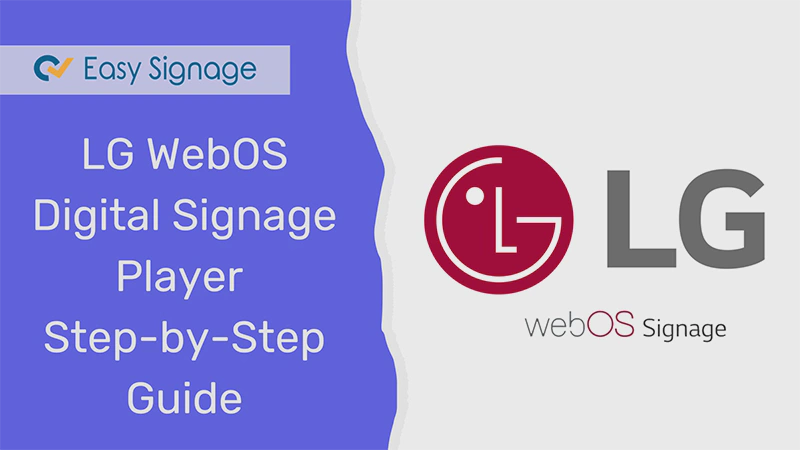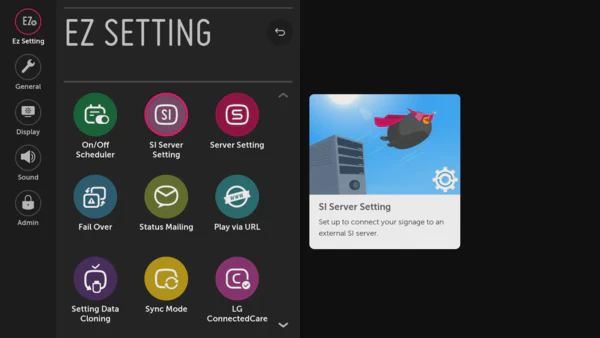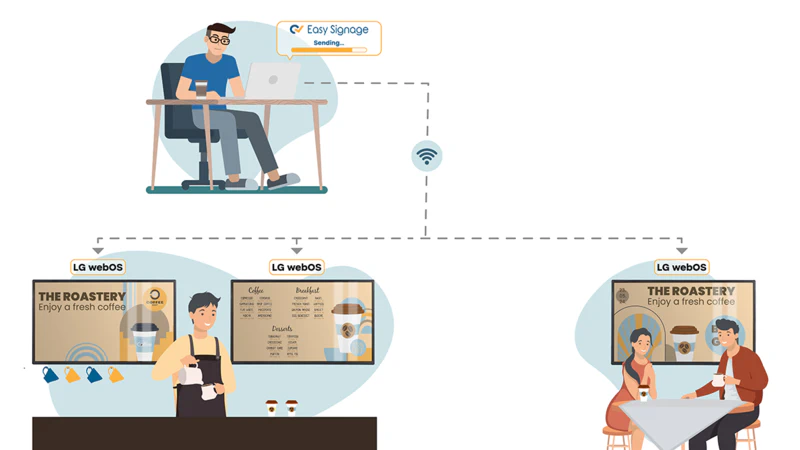LG WebOS Digital Signage Player: Step-by-Step Guide

Choosing the right digital signage platform can significantly impact how effectively a business communicates with its target audience.
If you’re considering several digital signage players, this post will guide you through LG WebOS digital signage and help you make an informed decision about your digital signage project.
We’ll explore why the LG WebOS digital signage player could be the perfect match for your business and guide you step-by-step on how to get the EasySignage app up and running on your LG WebOS device for free within minutes.
LG WebOS Defined
WebOS is a web-centric Linux operating system that powers the LG Digital Signage and is widely available in LG products like televisions and commercial displays, excluding smartphones.
LG WebOS Signage refers to a series of digital display solutions offered by LG that are powered by WebOS, originally developed by Palm in 2009 as a mobile operating system and later acquired by LG Electronics.
In the context of digital signage, WebOS provides Application Programming Interfaces (API) that enable digital signage content management systems (CMS) businesses like EasySignage to run their applications directly on LG signage displays without needing external devices. This process is made possible by the embedded system-on-chip (SoC) processor within LG WebOS signage displays.
What is SoC?
SoC stands for “System on a Chip,” an integrated circuit that combines all or most components of a computer or electronic system onto a single microchip. It usually includes a central processing unit (CPU), memory components (RAM and flash memory), input/output ports, and connectivity modules (like Wi-Fi and Bluetooth).
Applications of LG WebOS Digital Signage
WebOS digital signage displays are versatile and widely used in various industries, including:
✔️ Retails stores
✔️ Corporate Communications
✔️ Hospitality Industry
✔️ Healthcare Facilities
✔️ Educational Institutions
✔️ Public Transportation
✔️ Entertainment and Sports Venues
Install EasySignage on LG WebOS Digital Signage Player
Setting up EasySignage on your LG WebOS player is easy. Follow these steps to ensure a smooth installation and transform your screens into powerful marketing tools.
1. Prepare Your Equipment:
Ensure your LG WebOS digital signage display is connected to the internet, and you have your remote control.
Note that EasySignage supports LG WebOS 4.0 signage and higher. WebOS smart TVs are not supported.
2. Turn on Your Device:
Power up your LG WebOS player. Press the “Home” button on your remote control to bring up the WebOS interface.
To check the WebOS version of your display:
- Press the “Settings” button on your remote control.
- Navigate to the “General” section.
- Select “About this TV”.
- Make sure the signage version is 4.0 or higher.
3. Set Time and Date:
This step is important to enable communication between the EasySignage app and the cloud service.
- Press the “Settings” button (gear icon) on the remote control.
- Select “General”.
- Choose Time & Date.
- Select Set Automatically and ensure the time is set up correctly.
- Navigate to Timezone.
- Select the correct Continent, Country/Territory, and City.
4. Install the EasySignage App:
There are two methods to install the EasySignage app on LG WebOS digital signage players:
- Via the Internet, which is preferred.
- Using a USB drive.
Install EasySignage Via Internet:
Press the Settings button (gear icon) on your remote control.
Navigate to EZ SETTING.
Select SI Server Setting and continue.

Choose SI Server Setting.
Configure the following steps in order:
- Fully Qualified Domain Name: Enabled
- Address URL: https://appds.io/lg
- Application Launch Mode: Local
- Application type: IPK
- Auto set: “Off” (this setting may not always be visible).
- Go to Local Application Upgrade and select Remote.
- Press the OK button to confirm.
- A pop-up message will appear, “Start Application Upgrade”.
- Wait for the message to disappear, then turn off the device using the remote control.
- Wait 10 seconds, and then turn the TV back on.
- The EasySignage app will launch.
Install EasySignage Using USB Drive:
Download the latest version of EasySignage from the following link: https://download.easysignage.com/easysignage/com.lg.app.signage.ipk
Important step: Once the download is complete, you should rename the downloaded file from .ipk to com.lg.app.signage.ipk.
Format the USB drive to FAT32.
Create a folder named “application” at the root of the USB drive (keep all names in lowercase).
Place the renamed com.lg.app.signage.ipk file to the created “application” folder.
Plug the USB drive into the LG WebOS device and power it on.
Press the Settings button on the remote control.
Navigate to EZ SETTING.
Select SI Server Setting and continue.
Choose SI Server Setting.
Configure the following steps in order:
- Application Launch Mode: Local
- Application Type IPK
- Go to Local Application Upgrade and select USB.
- Press the OK button to confirm.
- A pop-up message will appear, “Start Application Upgrade”.
- Wait for the message to disappear, then turn off the device using the remote control.
- Wait 10 seconds, and then turn the TV back on.
- The EasySignage app will launch.
For more detailed instructions on how to Install the EasySignage app on LG WebOS digital signage, please refer to the help page.
5. Log in to EasySignage:
The EasySignage app will launch on your device once installed. Go to the management console on your Chromium browser, log in with your EasySignage account, or sign up for free to start setting up your content.
6. Customize Your Content:
EasySignage provides a user-friendly dashboard to create and manage digital signs. Upload your images, videos, and other media, or choose from various templates to get started quickly.
7. Publish Your Display:
After setting up your content, push it live to your screens. You can update and modify it anytime from the EasySignage dashboard.

LG WebOS Media Player WP400
The LG WP400 box is a media player that runs on the WebOS platform and is designed for digital signage applications in commercial settings. It’s part of LG’s product lineup of signage solutions, which offers a variety of content across commercial displays.
The WP400 is particularly notable for its use in environments where digital signage requires reliable, continuous operation, such as retail, hospitality, education, and corporate settings.
Key Features of the LG WP400:
WebOS Support: The LG WP400 runs on LG’s WebOS for Signage, a commercial operating system designed to make content management and deployment easy.
High Performance: Equipped with a powerful SoC (System on a Chip), the media player can execute multiple tasks efficiently, from playing high-definition content to supporting various multimedia formats.
Versatile Connectivity: This device offers a range of connectivity options, including HDMI, USB, and RJ45 (Ethernet), making it versatile for different digital signage setups.
Integration Capabilities: Its design allows easy integration into existing setups with minimal disruption, and it supports various third-party software applications, such as EasySignage Software, through its open API.
Secure Operation: The WP400 includes security features that protect against unauthorised access and ensure the safe operation of the digital signage network.

Benefits of Integrating EasySignage with LG WebOS Digital Signage
LG WebOS is a reliable and user-friendly digital signage technology that comes with advanced features, making it a strong candidate for any business looking to invest in digital signage. By integrating with EasySignage, companies can enjoy a range of benefits that can enhance the functionality, management, and impact of digital displays across various industries. Here are some of the key advantages:
Reliability and Security:
LG’s products are tested for long-term performance, making them suitable for the demanding digital signage operations that often require near 24/7 uptime.EasySignage provides secure options for managing and storing sensitive content, often displayed in public or corporate environments.
High-Quality Technology:
LG combines its advanced display technologies, such as OLED and Ultra HD screens, with WebOS to deliver high-quality visuals for digital signage.Enhanced Content Management:
EasySignage offers a user-friendly platform for creating and managing content, making it easier to maintain multiple screens. Users can control the content across multiple displays from a single dashboard, which is ideal for businesses with extensive digital signage networks, such as franchises, retail chains, and organisations with multiple office sites.Real-Time Updates:
With EasySignage, you can update content such as news, promotions, weather, and alerts in real time, keeping the information fresh and relevant. You can also schedule the content to be displayed at specific times, automating the process and ensuring the right message plays at the right time.Interactive and Engaging Displays:
When used with LG WebOS’s touchscreen capabilities, EasySignage can help create interactive displays that engage users and give them control over the content displayed.Reduced Hardware Requirements:
EasySignage runs directly on LG WebOS, reducing hardware costs and setup complexity.
Wrapping Up
Integrating EasySignage with LG WebOS Digital Signage Players provides businesses with a powerful toolset for enhancing their advertising, communication, and engagement strategies. By following the steps outlined above, you can set up your digital signage solution and start captivating your audience with dynamic, impactful displays.
Why not give it a try and see the difference it makes in your customer engagement?
Remember, the success of your digital signage lies in both the technology you use and the quality of content you display.